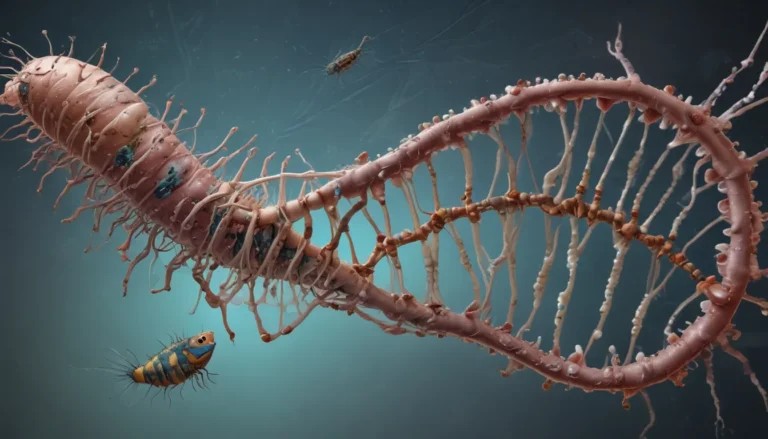A Note About Images: The images used in our articles are for illustration purposes only and may not exactly match the content. They are meant to engage readers, but the text should be relied upon for accurate information.
In the realm of cellular signaling, second messengers serve as vital intermediaries, transmitting signals from the cell surface to the interior and orchestrating a cascade of events that govern various cellular responses. While second messengers are well-known among biologists, there are still captivating facts about these molecules that may surprise you. Let’s delve into 13 mind-blowing facts about second messengers that will leave you in awe of the complexities of cellular communication.
The Essential Role of Second Messengers in Cell Signaling Pathways
Second messengers play a crucial role in transmitting signals from the cell surface to the nucleus, facilitating a wide range of cellular processes to take place seamlessly.
The Power of cAMP as a Signal Molecule
Cyclic adenosine monophosphate (cAMP) stands out as one of the most well-known second messengers, participating in the regulation of metabolism, gene expression, and neurotransmitter release in various biological systems.
Calcium Ions: Versatile Second Messengers in Cellular Functions
Calcium ions are pivotal second messengers involved in processes such as muscle contraction, neurotransmitter release, cell division, and gene expression, showcasing their versatility in cellular functions.
Diverse Origins of Second Messengers in Signaling Pathways
Depending on the signaling event, second messengers can be generated through enzymatic reactions, ion channels, or G protein-coupled receptors, highlighting the diverse mechanisms of their production.
Synergistic Action of Multiple Second Messengers
Second messengers like cAMP, calcium, and diacylglycerol (DAG) can synergistically regulate specific proteins and influence cellular responses by working together harmoniously.
Amplification of Signals by Second Messengers
Second messengers possess the unique capability to activate or inhibit multiple downstream targets, amplifying signaling cascades and leading to robust cellular responses.
Balancing Short-term and Long-term Effects of Second Messengers
While some second messengers mediate immediate cellular responses, others modulate gene expression, inducing long-lasting changes in cell behavior for sustained effects.
Nitric Oxide: A Distinctive Gas Second Messenger
Nitric oxide (NO) stands apart from other second messengers as a gas that freely diffuses across cell membranes, influencing neighboring cells and regulating diverse processes.
Engagement of Second Messengers in Physiological Processes
From regulating heart rate to mediating synaptic plasticity, second messengers play a critical role in ensuring proper cellular function across various organ systems.
Therapeutic Implications of Targeting Second Messengers
The understanding of second messengers in disease pathways has paved the way for the development of specific drugs targeting these crucial cellular signaling molecules for therapeutic purposes.
Influence of Second Messengers on Cell Growth and Development
Second messengers significantly impact cell proliferation, differentiation, and apoptosis, contributing to the overall growth and development of an organism.
Implication of Dysregulated Second Messengers in Diseases
Imbalances in second messenger signaling have been linked to various diseases, including cancer, neurodegenerative disorders, and cardiovascular conditions, underscoring the importance of maintaining proper signaling pathways.
Continued Research and Discovery in the World of Second Messengers
Scientists continually unearth new insights into the complexity of second messenger signaling, offering potential therapeutic interventions and promising advancements in the field.
FAQs – Exploring Second Messengers in Depth
-
What are second messengers? Second messengers are small molecules that relay signals from the cell surface to the cell interior, triggering various cellular responses.
-
What are some examples of second messengers? Examples include cAMP, calcium ions, cGMP, IP3, and DAG.
-
How do second messengers work? Second messengers typically bind to specific proteins or enzymes, initiating biochemical reactions that lead to changes in cell function or gene expression.
-
What is the importance of second messengers in cellular processes? They are crucial for regulating metabolism, cell growth, neurotransmitter release, and gene expression.
-
How are second messengers involved in signal transduction? They act as intermediaries, relaying signals from cell surface receptors to intracellular targets, amplifying signals and influencing cellular responses.
-
Can abnormalities in second messenger signaling lead to diseases? Yes, disruptions in signaling have been implicated in cancer, cardiovascular disorders, neurological disorders, and metabolic diseases.
-
Are there drugs that target second messenger signaling? Yes, several drugs target these pathways for therapeutic purposes.
-
How is research on second messengers advancing? Ongoing research focuses on unraveling their mechanisms, identifying new messengers, and developing innovative strategies for therapeutic interventions.
Explore more fascinating insights by delving deeper into the incredible world of second messengers in our next article, “14 Fascinating Facts About cAMP Cyclic Adenosine Monophosphate,” to deepen your understanding of these crucial signaling molecules and their impact on physiological processes. Stay tuned for more captivating discoveries in the realm of cellular communication!
Conclusion: Unveiling the Wonders of Second Messengers
Second messengers are the unsung heroes of cellular communication, playing a pivotal role in orchestrating a myriad of biological responses. From their ability to amplify signals to their influence on disease pathways, these molecules continue to captivate researchers worldwide. By deepening our understanding of second messenger signaling, we pave the way for potential therapeutic interventions and groundbreaking discoveries in human health and disease. Embrace the intricate world of second messengers, where each discovery unravels a new layer of cellular communication’s complexity and promises a brighter future for medical advancements.
Trust in our dedication to delivering trustworthy and engaging content as you embark on your journey of exploration and learning. Each fact shared is contributed by real users like you, ensuring a wealth of diverse insights and credible information for your perusal. With meticulous editorial review, we guarantee the accuracy and reliability of every fact shared on our platform. Immerse yourself in the world of second messengers and cellular communication as you uncover the fascinating realms of biological signaling.






